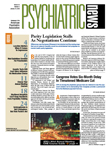Neuroimaging studies in people with bipolar disorder (BPD), even those having their first episode, show widespread involvement of brain cortical and subcortical areas. Follow-up studies of people newly diagnosed with BPD show that remodeling occurs in brain regions involved in the illness, with gray matter loss and white matter abnormalities—changes linked to deficits in managing emotions, thinking, and other brain functions.
These changes highlight the need for earlier diagnosis of BPD and treatment not just of acute flare-ups, but also of the disease process to prevent long-term disability, according to Husseini Manji, M.D., of the National Institute of Mental Health (NIMH).
While the extremes of mania usually prompt a fairly rapid diagnosis of BPD I, the more subtle mood disturbances of BPD II often delay diagnosis for nine to 12 years, Manji said. Some people with BPD II, thought to have a recurrent major depressive disorder, receive antidepressants without a mood stabilizer. Such treatment puts them at risk of cycling rapidly between mania or hypomania and depression.
When offered mood stabilizers, patients often express concerns about side effects. “If we can convince them that these medications protect the brain,” Manji said, “they may be more willing to stick with treatment.”
An estimated 5.7 million adults in the United States, or about 2.6 percent of the population aged 18 and over, annually experience symptoms associated with BPD. The median age of BPD onset is 25. Onset of BPD before age 13 occurs mainly in males.
Heightened recognition of long-term poor outcome in BPD, along with newly diagnosed adults' frequent reports that their depression and other BPD symptoms started early in life, have prompted new interest in assessment of children and adolescents with symptoms suggestive of BPD.
The rate of diagnosis of BPD in youth aged 19 and younger increased 40-fold in the United States in the past decade, researchers at the New York State Psychiatric Institute, and NIMH and colleagues reported in the September 2007 Archives of General Psychiatry. They based their findings on data from the National Ambulatory Medical Care Survey. Whether the disorder actually has become more common, was underdiagnosed in the past, or is overdiagnosed today, Manji said, is not yet clear.
“Children with a family history of BPD who display a reduced need for sleep and other symptoms of the disorder need careful evaluation and follow-up,” he said. “Some may benefit from lifestyle interventions, such as education in sleep-management strategies. But medications should be reserved for only those with strong evidence of BPD.”
